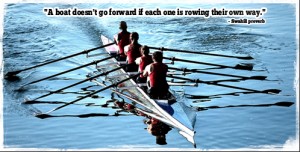Likely nowhere in an organization is teamwork more important than at the top. Executive leadership teams can be a potent force charting a sustainable competitive course, communicating direction, crafting winning cultures, and aligning their organizations around strategic priorities. Yet too few executive teams operate at the top of their game; here are some guidelines for how they can:
- Do top team members own a common purpose that contributes distinct value?
Each member of an executive team already plays a significant leadership role heading a business unit or function with its own distinct purpose and set of goals. Executive team members share a vital collective responsibility, however, that goes beyond their individual functional leadership roles. It is worthwhile for executive teams to articulate their distinct shared purpose and the collective value they contribute that no other entity can. Here is how one executive team client defined its unique value-added role:
“Leverage our collective perspectives and resources to serve (name of organization) by anticipating challenges and opportunities, crafting strategic direction and speaking with one voice to engage internal and external stakeholders.”
As with most efforts to define collective purpose, the process is almost more important than the product; it answers the all-important “why are we here?” question and serves as an important team development experience in its own right.
- What goals are executive team members mutually accountable for? Along with a common purpose or mission, mutual goals are the
 foundation for any team, including executive teams; no goals, no team. For a group of senior executives to function as a true team, there must be shared goals that require collaboration and collective contributions. Too often as one experienced senior leader shared, a crisis becomes the executive team’s only shared goal.
foundation for any team, including executive teams; no goals, no team. For a group of senior executives to function as a true team, there must be shared goals that require collaboration and collective contributions. Too often as one experienced senior leader shared, a crisis becomes the executive team’s only shared goal.
Common goals can be a challenge for senior teams, composed of strong leaders who all have their own challenging functional unit goals. In some cases those sets of goals can conflict; challenging individual goals combined with rich incentives to achieve them they can take precedence over collaborating on mutual goals.
Common c-suite goals often reflect the most important dimensions and operations of an organization that do not fall neatly into any particular function. Beyond traditional measures like revenue growth, profitability and share price for publicly held corporations, examples include health of the organization’s culture, customer service, ethics and reputation. Of course to compete fairly for executive teams members’ attention alongside their individual functional objectives, compensation and bonuses need to be aligned with shared goals.
- Have executive team members articulated mutual expectations or norms for working together, and do they hold each other accountable
 for those? Any team’s members can have different styles and expectations for working together; that is especially the case when teams are composed of members from different organizations and cultures. Conversation early in the game and periodic check-ins about meeting formats, communication preferences, “rules of the road” and other mutual expectations saves time later and lays a foundation for greater trust.
for those? Any team’s members can have different styles and expectations for working together; that is especially the case when teams are composed of members from different organizations and cultures. Conversation early in the game and periodic check-ins about meeting formats, communication preferences, “rules of the road” and other mutual expectations saves time later and lays a foundation for greater trust.
Ideally mutual expectations include authentic communication and speaking with one voice. Authentic communication assures the kind of respectful disagreement and dialog required for making the best decisions. When that has been the case, executive team members need to hold themselves accountable for speaking with one voice about decisions and direction. One of the biggest detractors from healthy cultures and execution is lack of unified communication; examples include publicly second-guessing executive team decisions that have already been made or unintentional misrepresentation of decisions or direction.
Decision-making protocols are also important to clarify. When and how will voting or consensus be used? If one person decides in the end, will there be circumstances when that isn’t the executive team leader or CEO? Which decisions are an executive team’s or its leader’s call, and which are a board’s?
When top teams need a “tune up,” here are some suggestions:
- Basic navigation principles apply: before knowing where to go, senior teams need to know where they are. In that regard, I conduct interviews with all senior team members before team development engagements; I summarize responses anonymously to reflect perceived team strengths, limitations, opportunities and dynamics. I usually supplement that with a commercial senior team survey or one that I design.
- There may not be an “I” in team, but there is a “me.” Senior teams are composed of individuals; if we want strong teams we need to invest in development of team members, especially its leader. A 2008 Hay study of executive teams revealed that an executive team leader’s leadership style accounts for 70% of the team’s climate; further, that climate accounts for 30% of the variance in executive team contributions. Senior team development is best accompanied or preceded by team member coaching, including survey-feedback.
- The best senior team development is in the context of their real work, including strategic planning, critical decisions to make, conflicts about direction or dysfunctions to address. Senior teams are often more inclined to invest in team development with the prospect of simultaneously achieving other critical tasks.
- My senior team work always ends with commitments – collective and individual commitments about what will be done, how team members will work together and individual roles. Commitments are shared, and agreements made about measuring progress and how team members will be mutually accountable for following through. A time should be set for a formal facilitated review by the team of progress on goals and commitments.
The health and effectiveness of top teams are too important to leave to chance; I hope that these are useful guidelines for assuring that your top team is at the top of its game. 
“Yet with a culture of individual accountability and self-reliance pervading executive suites, few senior executive groups ever function as real teams.”
Jon R. Katzenbach, Teams at the Top
“You may have the greatest bunch of individual stars in the world, but if they don’t play together, the club won’t be worth a dime.”
Babe Ruth
